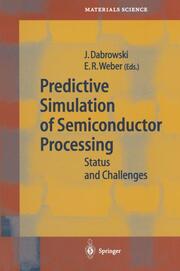-
Kurztext
-
Predictive simulation of semiconductor processing enables researchers and developers to extend the scaling range of semiconductor devices beyond the parameter range of empirical research. It requires a thorough understanding of the basic mechanisms employed in device fabrication, such as diffusion, ion implantation, epitaxy, defect formation and annealing, and contamination. This book presents an in-depth discussion of our current understanding of key processes and identifies areas that require further work in order to achieve the goal of a comprehensive, predictive process simulation tool.
-
-
Autorenportrait
- J. Dabrowski: Born in Warsaw, Poland, Sept. 29, 1958. PhD, Institute of Physics of the Polish Academy of Science (IF PAN), Warsaw, 1989. Scientific staff member IF PAN 1983-1992; postdoctoral fellow Fritz Haber Inbstitute of the Max Planck Society, Berlin, Germany, 1990-1991; postdoctoral fellow Xerox Palo Alto Research Center, California, 1992; since 1993 with IHP-microelectronics, Frankfurt (Oder), Germany. Conference series chairman, Challenges in Predictive Process Simulation (1997, 2000, 2002); international advisory commmittee member, International Training Institute for Materials Science, Hanoi, Vietnam. Project leader, German Research Society (1998-2000); von Neuman Institute for Computing (since 1993). Author (monograph), "Silicon surfaces and formation of interfaces; basic science in the industrial world" (World Scientific, 2000). Editor (book), ""Recent Developments in Vacuum Science and Technology" (Research Signpost, 2003). Research in atomic diffusion mechanism in solid state; atomic structure of surfaces and semiconductor/dielectric interfaces; atomic structure of defects in semiconductors and insulators; signal processing for telecommunication. Achievements include discovery of atomic structure of the clean Si(113) surface; atomic structure of the main electron trap in GaAs (EL2 defect); atomic structure of the interface between a high-K dielectric (Pr2O3) and Si(001). Patents for silicon microelectronic technology; patents pending for telecommunication.
Detailansicht
Predictive Simulation of Semiconductor Processing
Status and Challenges, Springer Series in Materials Science 72
ISBN/EAN: 9783642058042
Umbreit-Nr.: 1567944
Sprache:
Englisch
Umfang: xvii, 490 S., 161 s/w Illustr., 16 farbige Illustr
Format in cm:
Einband:
kartoniertes Buch
Erschienen am 04.12.2010
Auflage: 1/2004


